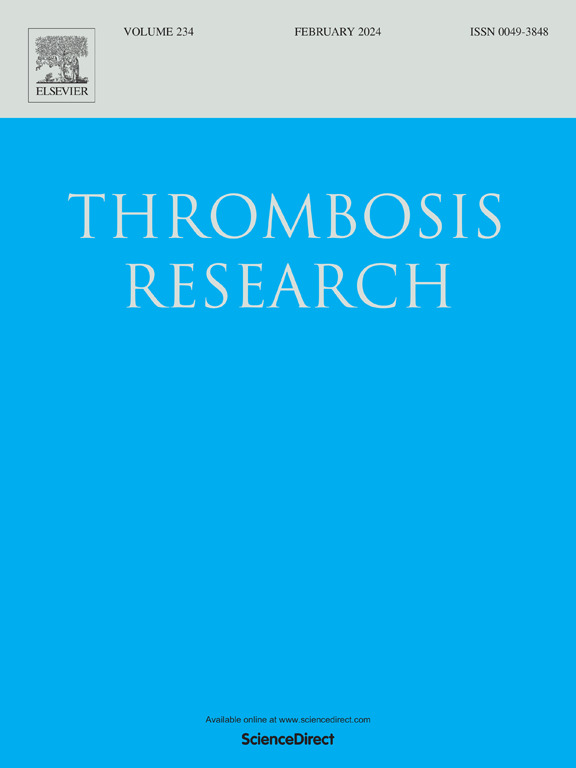Risk factors for thrombocytopenia in adult patients with sepsis: A systematic review and meta-analysis
IF 3.4
3区 医学
Q1 HEMATOLOGY
引用次数: 0
Abstract
Background
Sepsis-induced thrombocytopenia (SIT) is a frequent hematological complication in critically ill patients. However, the independent risk factors for SIT remain controversial. This meta-analysis aims to identify independent predictors of SIT in adult septic patients.
Objective
To identify risk factors for SIT and explore their potential implications for early risk stratification and platelet-targeted intervention in sepsis.
Methods
PubMed, Embase, Cochrane Library, Web of Science, CNKI, and Wanfang databases were searched from inception to April 2025. Studies reporting multivariable-adjusted associations between candidate risk factors and SIT were included. Data extraction and quality assessment were performed independently by two reviewers. Newcastle-Ottawa Scale was used for quality assessment. Pooled odds ratios (ORs) and mean differences (MDs) were calculated using RevMan 5.3 and Stata 15.0.
Results
A total of 14 studies involving 14,316 septic patients were included. The pooled incidence of SIT was 37.9 %. In the primary analysis using the conventional threshold of PLT <100 × 109 L−1, elevated lactate, higher SOFA scores, and lower WBC count were associated with SIT. Subgroup analyses at PLT <150 × 109 L−1 yielded consistent results for lactate and WBC, while SOFA retained significance only at the stricter definition. No significant publication bias was detected.
Conclusions
This meta-analysis demonstrated that elevated serum lactate, higher SOFA scores, and lower white blood cell count are significantly associated with SIT. Given the structural overlap between SOFA score and thrombocytopenia, further studies are needed to validate its independent role. Early identification of these predictors may help improve risk stratification and clinical management in septic patients.
成人脓毒症患者血小板减少的危险因素:一项系统回顾和荟萃分析
背景败血症性血小板减少症(SIT)是危重患者常见的血液学并发症。然而,SIT的独立危险因素仍然存在争议。本荟萃分析旨在确定成人脓毒症患者SIT的独立预测因素。目的确定SIT的危险因素,并探讨其对脓毒症早期风险分层和血小板靶向干预的潜在意义。方法检索spubmed、Embase、Cochrane Library、Web of Science、CNKI、万方等数据库,检索时间为建库至2025年4月。研究报告了候选危险因素与SIT之间的多变量调整关联。数据提取和质量评估由两名审稿人独立完成。采用纽卡斯尔-渥太华量表进行质量评价。使用RevMan 5.3和Stata 15.0计算合并优势比(ORs)和平均差异(MDs)。结果共纳入14项研究,14316例脓毒症患者。SIT的总发病率为37.9%。在使用常规阈值PLT (100 × 109 L−1)的初步分析中,升高的乳酸水平、较高的SOFA评分和较低的WBC计数与SIT相关。在PLT和150 × 109 L−1的亚组分析中,乳酸和白细胞的结果一致,而SOFA仅在更严格的定义下保持显著性。未发现显著的发表偏倚。结论:该荟萃分析表明,血清乳酸水平升高、SOFA评分升高和白细胞计数降低与SIT显著相关。鉴于SOFA评分与血小板减少症之间的结构重叠,需要进一步的研究来验证其独立作用。早期识别这些预测因素可能有助于改善脓毒症患者的风险分层和临床管理。
本文章由计算机程序翻译,如有差异,请以英文原文为准。
求助全文
约1分钟内获得全文
求助全文
来源期刊

Thrombosis research
医学-外周血管病
CiteScore
14.60
自引率
4.00%
发文量
364
审稿时长
31 days
期刊介绍:
Thrombosis Research is an international journal dedicated to the swift dissemination of new information on thrombosis, hemostasis, and vascular biology, aimed at advancing both science and clinical care. The journal publishes peer-reviewed original research, reviews, editorials, opinions, and critiques, covering both basic and clinical studies. Priority is given to research that promises novel approaches in the diagnosis, therapy, prognosis, and prevention of thrombotic and hemorrhagic diseases.
 求助内容:
求助内容: 应助结果提醒方式:
应助结果提醒方式:


